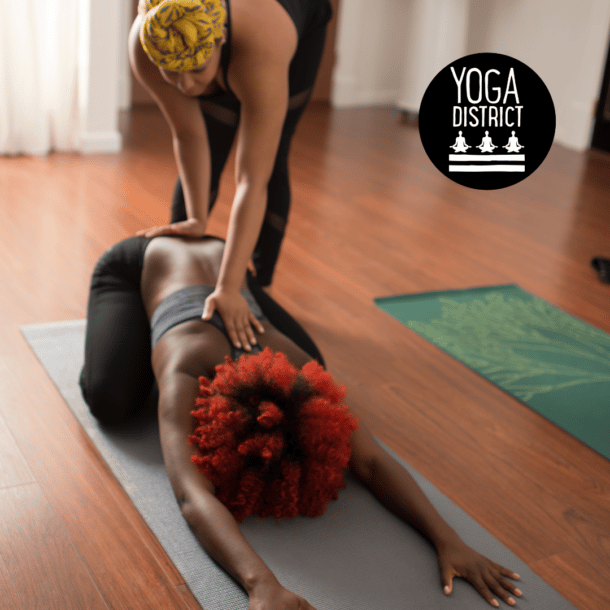Learn from beloved teacher Jessie M. how to keep your online yoga practice going strong. Jessie also describes how online yoga has some surprising benefits, including “taking the ego out of the practice.”
In this post we interview Jessie M., beloved, longstanding YD teacher who presently teaches online and Dupont-studio-based Prana Flow and Yin classes. Find out what motivates her practice and how online yoga can be a huge benefit for your wellness routine.
What is your favorite style of class to teach online and why?
The start of the pandemic dramatically shifted my practice. I went from loving fiery vinyasa classes in the studio to needing a bit more self-soothing at home. Accordingly, I took Michelle B.’s 30-(now 50!)-hour yin training online and began teaching the practice shortly thereafter. Perhaps it’s because I was trained and taught largely online, but I love sharing the practice virtually today. Students can choose whether or not to share their screens, but when they do I get to bear witness to ultimate release & relaxation. Cozy in their homes with their own music, lighting, and prop environment, students can and do make the practice their own; it’s a beautiful practice to share!
What are the benefits of taking an online yoga class?
It helps to take my ego out of the practice. In-studio, I was & still can be extremely guilty of trying to take the most advanced variation cued– even if that version wasn’t directed at me. At home, I often keep my camera on, but some days I just sit out sequences in a child’s pose or work a totally different posture if that’s what I need. No other practitioners at home or in the studio is watching, and my teachers are so respectful when it comes to making the practice my own. On days I need to exert energy, the studio is there; but when I need nourishment, I can take it easier at home.
Beyond the physical benefits, what are the top three things yoga has taught you?
I think the ultimate lesson is acceptance, but if I had to break it down to three things:
1. Patience — both my yin & yang practices have highlighted that you can’t force the body to do something it’s not ready to do. I used to try to force poses or get sloppy in an effort to break past physical barriers. Now, when my breath stops or shortens, I know I’ve gone too far for that practice.
2. Gratitude — It starts on the mat, with the abovementioned patience. I’ve come to appreciate the poses that feel good or are fun! I celebrate the breakthroughs when they happen (which, by the way, I’ve had fewer of in some styles since COVID-began, so if you’re challenged in this way at home– I’m with you!). Practicing at home got me out of my head and, mentally, off the mat next to me where a student was performing an asana I couldn’t achieve in the same way.
3. When to Indulge– Now asana practice is much more about moving my body in a way that feels good that day. I take different variations than cued in group classes and encourage my students to do the same. I’m not always accepting, but more often now, if the handstand isn’t happening, I indulge in a down dog as it’s both an inversion and a posterior chain stretch that forever feels so good!
Applying these off the mat is still a challenge, but 18 months of home practice has helped me make the connection between the mat, my ego, and how I approach my day-to-day in a new way.
Please describe a challenging moment that you have experienced teaching, how you faced that challenge, and what you learned from it?
In my yin teacher training, Michelle B offered really pointed– but rarely shared feedback– that while I may feel a posse a certain way and take a certain variation, different students have very unique experiences with that “same” asana. In-studio flow classes, I would breeze through poses, asking students to listen to their body & adjust as they needed. Now, I realize that as a teacher, I need to be sensitive to experiences that I cannot so much as fathom in a given pose– whether it’s a yin or a vinyasa class. Rather than just recognizing that some bodies prefer “lazy” folded pigeon and others need to take the pose in a supine position; I try to think about how my cueing can be more supportive (not to mention, inclusive) for all. However, the reality is that I just can’t know what a given student is feeling. Accepting this, I encourage students to be vocal with me either one-on-one or, if they’re comfortable, to speak up as needed throughout practice. By doing this, I think students can help to teach the teacher and expand our understanding of the poses outside of our own experiences. So please, if you take my class and something feels off or otherwise doesn’t resonate, let me know!
What can students do to stay motivated in their online practice?
Try new styles! As I’ve said, yin became my safe space during the pandemic. Take the opportunity to sign up for a class you wouldn’t otherwise. Afraid yin won’t be your thing? Take it at home and save yourself the commuting time to the studio– if you’re really not feeling it, you have the ability to take what you need from the class without distracting anyone else. Always take yin and restorative but not a fan of vinyasa? Try an online beginner class, or if you find yourself in all levels sub in extra “rest” poses from your preferred practices. Once you feel like you’ve tried all the styles out there (that’s not possible, right?) add new teachers into the mix as your schedule allows; the same benefits will apply!


